Different types of indoor lighting exist, and correctly identifying them, both from a function point of view and the choice of lighting fixtures, will determine the success or otherwise of the entire lighting design project.
As architects and interior designers know well, lighting is a very important aspect in interior design that often runs the risk of being overlooked.
In fact, correct lighting is able to make a difference in the way spaces are perceived, as well as affect the mood and state of mind of those who live there.
Giving the right light to any environment by proposing solutions capable of combining aesthetics and functionality is the goal that a well-structured lighting project should aspire to.
With this in mind, it is essential that professionals are perfectly familiar with the different indoor lighting systems, each of which has its own purpose and function and a different effect on the environment.
In this article, we will explore the different types of indoor lighting and will provide some advice on how to choose the right one based on the environment.
In particular, we will take a look at:
- How many types of lighting are there?
- How many types of designer indoor lighting are there?
- How to choose the right lighting
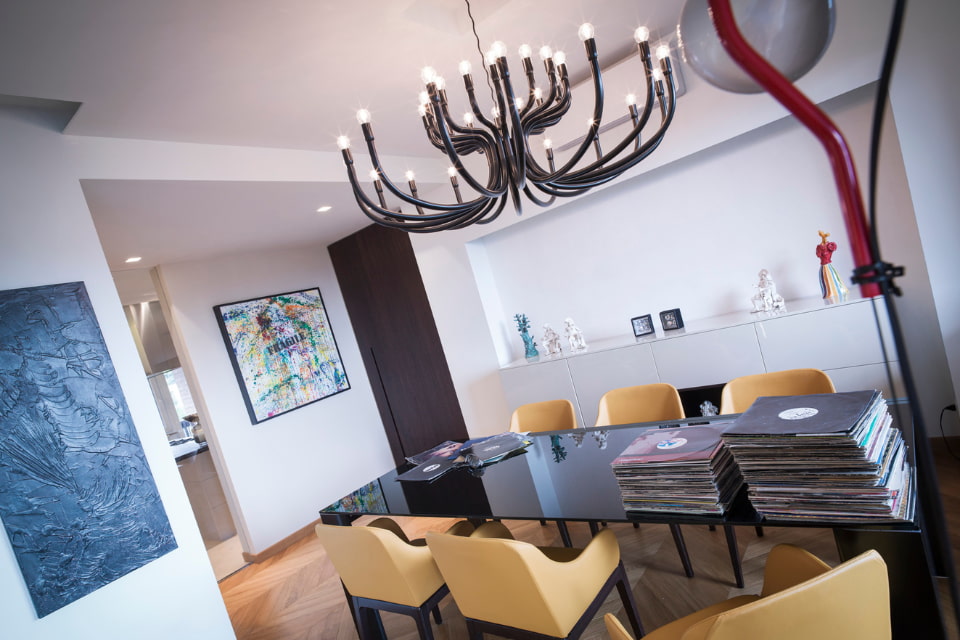
Snoob
How many types of lighting are there?
When it comes to types of indoor lighting, a vast universe opens up.
In fact, the different types of lighting are not distinguished on the basis of a single criterion but are made up of several sub-categories, each of which must be carefully evaluated in the implementation of a lighting design project and that are not only about the type of lamps but also the kind of atmosphere you want to create. It is the function attributed to light in the specific case.
Let's analyze them in detail.
Natural light and artificial light
Correct lighting starts from perfect integration between natural and artificial light.
Natural light, i.e. the one directly from the sun, is an ideal source of lighting for the indoors because it makes spaces more welcoming and creates a natural and relaxing atmosphere.
Therefore, in a lighting project, it is essential to make the most of it, taking into account doors, windows and, in general, all the elements that allow light to pass through.
With this in mind, the layout of the spaces is a determining factor. For example, a living area facing south, south-east, or south-west will allow you to enjoy the sunlight for many more hours a day.
So, the lighting design project should start from the assumption that natural light should be the main source of illumination, to make the environment not only more comfortable but also healthier for people's psycho-physical well-being.
The objective of artificial light should be to integrate natural light and provide for the lack of it in the evening and at night or on particularly dark days, however, approaching as much as possible to that of the sun.
Therefore, the work of the interior lighting designer will be to make the best use of various light sources, distributing them in a carefully studied and strategic way in the various environments, in order to create an optimal ratio of light and shadow that guarantees the right visual comfort.
All of these assessments become all the more important when it comes to illuminating a room without windows or where natural light is otherwise scarce.
In these cases, identifying the right type of artificial light for the indoors will be indispensable, not only in terms of functionality but for people's health itself.
Resorting to dimmable solutions, which allow you to adjust the light intensity according to the time of day and the atmosphere you want to create, represents a smart way to use artificial light.
Also, choosing low-energy, high-quality sources of artificial light will allow you to reduce consumption with an eye to eco-sustainability.
Finally, the choice of the right color temperature deserves a separate discussion.
Warm or cold light? How to choose the right color temperature of light
Warm light or cold light?
The choice of the right color temperature of the light is critical to define the type of atmosphere in every environment and will be different depending on the room and the lighting design project's location.
- Warm or extra warm white light (1700 - 2700 Kelvin) is indicated for environments in which intimacy plays an important role, such as, living rooms and lounge areas of clubs, bedrooms and relaxation areas, restaurants, hotels, or pubs
- Warm white light (3000 Kelvin) should preferably be used for transit areas, such as entrances, waiting rooms, stairways, and corridors
- Cool white light (4000 Kelvin), which gives way to a fresher, more energetic and vibrant atmosphere, is the best choice for work environments, to illuminate shops and retail spaces, but also, for example, the kitchen (between 3500k and 4000k).
It should be remembered that traditional incandescent or halogen bulbs do not allow you to choose the color of the light. To be able to have this opportunity, it is necessary to opt for LED bulbs.
3 types of indoor lighting: ambient, task, and accent lighting
There are 3 types of interior lighting and lighting professionals agree that a perfect lighting design project must include all of them to create layered lighting.
These 3 lighting levels are:
- Ambient lighting or general lighting, whose goal is to uniformly illuminate a room. For this type of lighting, spotlights, ceiling lamps, or suspensions are used based on the customer's tastes, the location's mood, and the characteristics of the environment.
Good general lighting is essential to create a welcoming and comfortable atmosphere - Task Lighting, that is, activity lighting, which is used to provide functional light to specific areas devoted to certain activities.
Let us think, for example, about the lighting of a kitchen hob or the dining table.
This type of lighting should be strong enough to illuminate the work area, but not so strong that it bothers or strains the eyes.
Great sources of task lighting are suspension lamps or table lights (for example, when it comes to providing task lighting to a desk or bedside table) - Accent lighting is used to create a dramatic effect or to highlight a piece of art or focal point in a room.
This type of indoor lighting is very important but is often overlooked. Great sources of accent lighting are, for example, spotlights or wall lamps, which allow you to create a contrasting light effect that gives great personality to the environment
Realizing a layered lighting project will therefore allow for optimal lighting both from the point of view of visual comfort and the functionality; it will create a sense of depth and give life to evocative plays of light to make each environment unique.
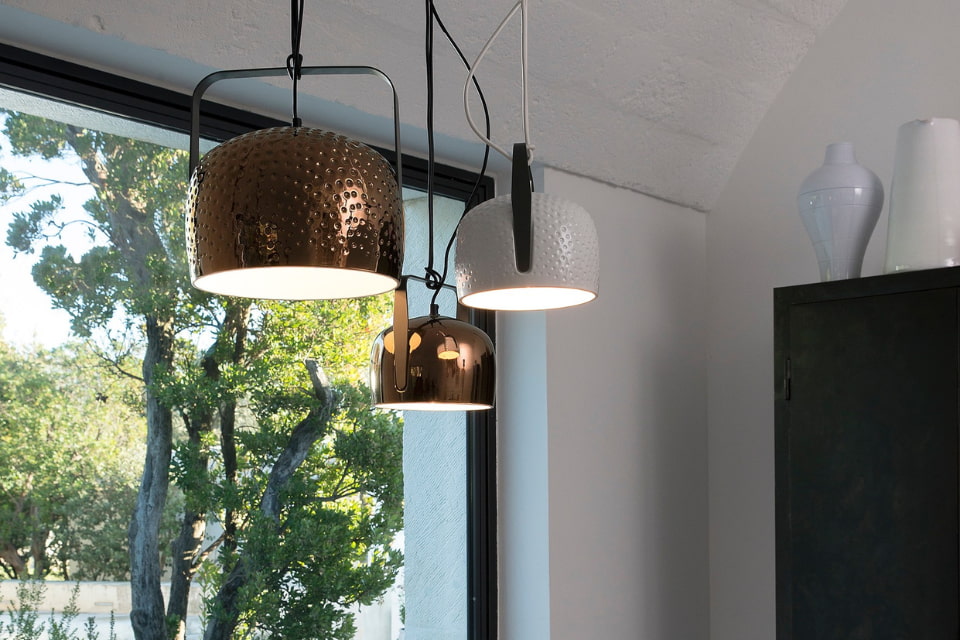
Bag
Decorative lighting and technical lighting
Among the different types of indoor lighting, an important distinction concerns decorative lighting and technical lighting, and the goal of a successful lighting design project is to find the perfect balance between the two to combine aesthetics and high performance.
Indoor decorative lighting: all the factors to consider
Using decorative lighting means going far beyond simply lighting up an environment efficiently.
It means creating a special atmosphere, highlighting particular design elements, and creating a unique emotional experience for those who experience a certain space.
Decorative lighting adds style and elegance and, more generally, it allows you to define the mood of a location by choosing an indoor lighting design capable of making an instant style statement.
Whether it is a private home or a contract environment, to properly design decorative lighting, some essential elements must be taken into consideration, which will then be evaluated on a case-by-case basis:
- The size of the room and the height of the ceiling. Just to give an example, in the case of low ceilings or small rooms, it is better to direct your choice towards designer ceiling or wall lamps rather than imposing chandeliers
- The style of the furniture. The chosen decorative lighting will have to be consistent with the overall concept. For example, if the style of the location is modern, it will be better to choose indoor lamps with a minimal design rather than a baroque style made up of more elaborate shapes
- The dimensions of the lamps must be proportionate to those of the environment
- The client's taste
- The purpose of the lighting. This point refers to what we have said about the three main lighting levels and will affect both the types of lamps and their placement
Finally, for the success of the lighting project, it is fundamental to find the perfect balance between decorative lighting and technical lighting.
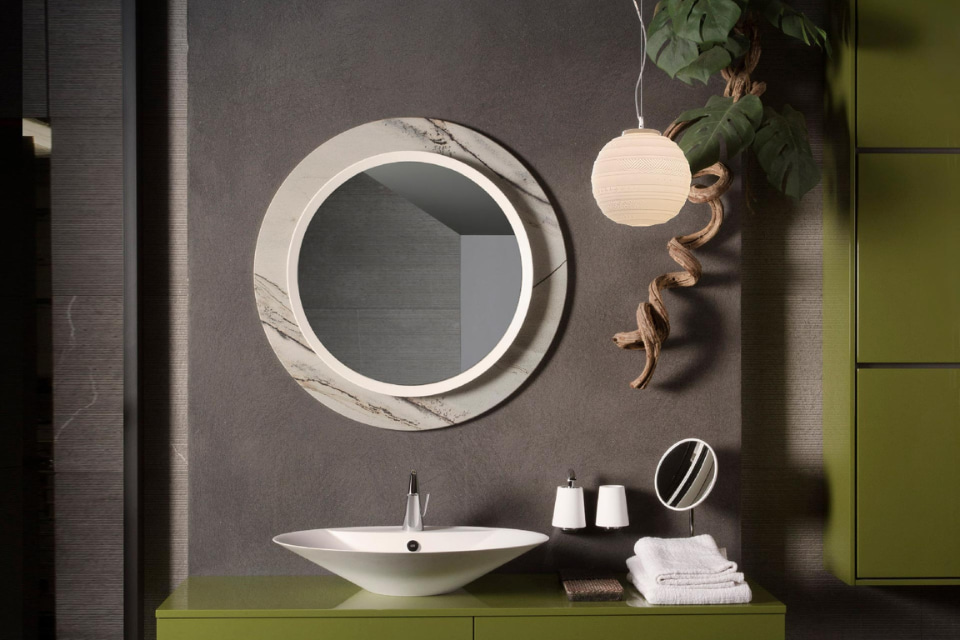
Braille
What is meant by technical lighting?
If the aesthetic component of the indoor lamps chosen for your project is fundamental, so are functionality and performance.
The synergy between luminous potential and style is important in order to outline the desired setting.
Technical lighting serves to uniformly illuminate an environment, ensuring the right amount of light to carry out daily activities.
Unlike decorative lighting, which mainly has an aesthetic function, technical lighting is designed to meet functional lighting requirements.
The use of technical lighting can, in fact, improve the experience of living and working in a given environment.
Good technical lighting increases productivity in the workplace, improves concentration and reduces eye strain, and helps reduce energy consumption and saves you money on your electricity bill.
Choosing the right technical lighting depends on the type of environment you want to illuminate, from the activities that take place there and the style of the location. It is important to choose quality lights and comply with safety standards when selecting and installing technical lighting.
Technical lighting starts from the calculation of energy requirements for ambient lighting.
To this end, it is necessary, first, to calculate how many lumens are needed to illuminate a room.
Lumen refers to the output of a luminous flux. It depends both on the surface to be illuminated and the intensity of the light, called lux (lumen= lux x mq).
The amount of lumens needed to illuminate an environment is also closely linked to the intended use of each specific space and the activities to which it is dedicated:
- The kitchen area requires perfect visibility quantifiable in approx. 350 lux
- The living room, as an area used for relaxation, 200 lux
- The bedroom needs a softer light that promotes rest and therefore requires 100 to 150 lux
- The bathroom needs two reference values, a generic one (150 lux) and one specific for the mirror (400 lux), the area requiring more task lighting
- For corridors and stairs a value of 150 lux can be used
These values, as we have said, must be multiplied by the square meters of the room and are considered indicative because they may undergo slight variations based on the specific objective of the lighting project.
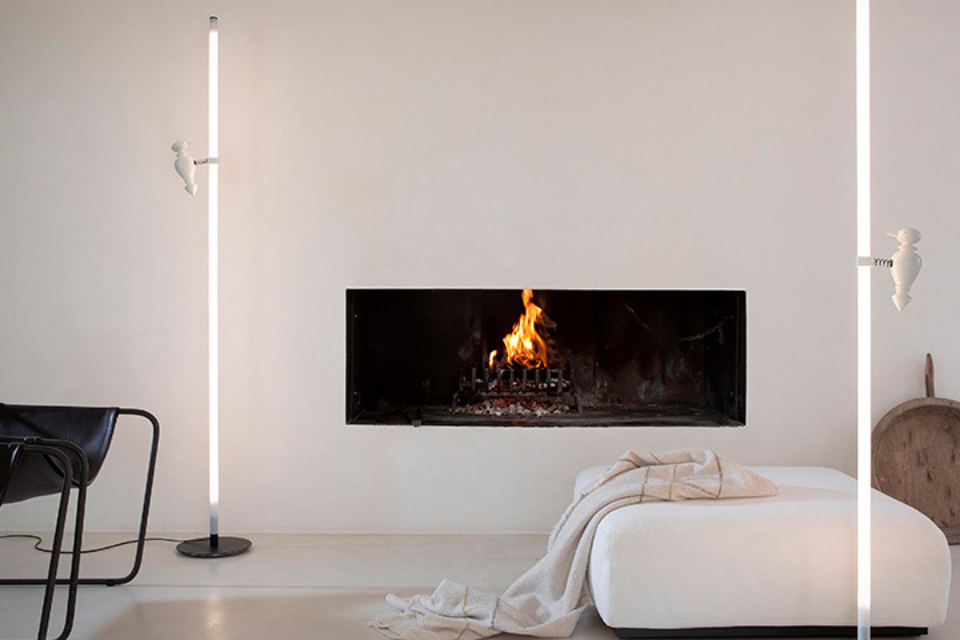
Accipicchio
Direct lighting and indirect lighting
Another fundamental distinction to keep in mind regarding the types of indoor lighting is that between direct lighting and indirect lighting.
Direct lighting is when light is emitted from a light source that directly illuminates the area below and is very useful as a source of task lighting when you need focused lighting.
An example of direct lighting is a suspension lamp above the dining table or the kitchen worktop.
Direct lighting can also be used for accent lighting, to focus attention on a specific area (like a stone wall, for example) or on a piece of designer furniture that you want to enhance (like a painting or a statue).
Instead, indirect lighting is when light is emitted from a light source which reflects off a surface (the ceiling or walls) and illuminates its surroundings.
An example of indirect lighting is a ceiling light, an LED strip, or a floor lamp, which emits the light towards the ceiling or walls.
This type of lighting is useful to create a warm and welcoming atmosphere and has the advantage of spreading evenly, without creating areas of light or shadows.
Two different lighting systems for the indoors, which, for a successful lighting design project, should be considered complementary and must be used wisely, each with their own specific objective.
How many types of designer indoor lighting are there?
In addition to the types of indoor lighting just analyzed, another distinction concerns the types of designer indoor lamps to choose from to give life to a project that gives optimal light to every corner of the house, adding at the same time lighting fixtures capable of decorating and embellishing the environment.
The important thing is to choose lamps which, in terms of shapes, dimensions, and design, integrate perfectly with the overall mood.
Let's look at the characteristics of each one and how to choose them based on the environment, bearing in mind that, in the final decision, it will be essential to satisfy the tastes and preferences of the client.
Suspension lamps
Transparent and brilliant, minimal or opulent. In glass or ceramic, in metal or fiberglass, declined on reinterpretations of classic shapes or shapes with an innovative and bold design, the suspension lamps are a timeless solution that furnishes, illuminates, fills, and embellishes spaces.
There are different types of suspension lamps, both single and as clusters. They represent a type of designer indoor lighting to create the right atmosphere in any environment, both as a source of ambient lighting and task lighting.
- In the living area, you can place one element or a combination of elements above the dining table as a source of direct light
- In the kitchen, one or more suspensions can effectively illuminate the hob or peninsula, giving at the same time a touch of elegance to the room
- In the bedroom, as well as in the center of the room for general lighting, a suspension lamp (of the right size) placed above the bedside table can provide perfect lighting for evening reading
These are just a few examples of where you can place suspension lamps. In fact, there are no limits to the use of this type of indoor lamp unless linked to the size of the spaces and the height of the ceilings.
In the case of particularly low spaces or low ceilings, it is advisable to not insert lighting fixtures that are too bulky, which would risk making the environment seem even smaller.
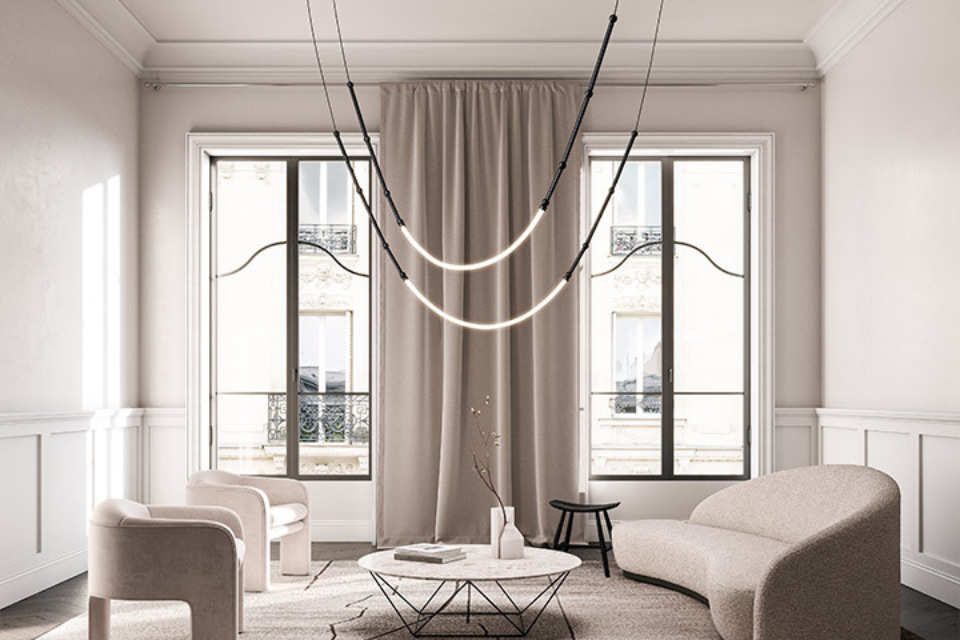
Leda
Ceiling lamps
Ceiling lamps are an extremely functional solution and, thanks to the fact that they don't create clutter, they are perfect even in the case of small rooms.
They can be installed in the living room, bathroom, and bedrooms, and in any other environment, providing diffused lighting throughout the room.
Ceiling lamps are available today in a wide variety of styles, from the more minimalist and modern ones to the more classic and decorative ones.
In any case, this type of designer indoor lighting is capable of creating works of art with particular finishes that redefine our domestic skies.
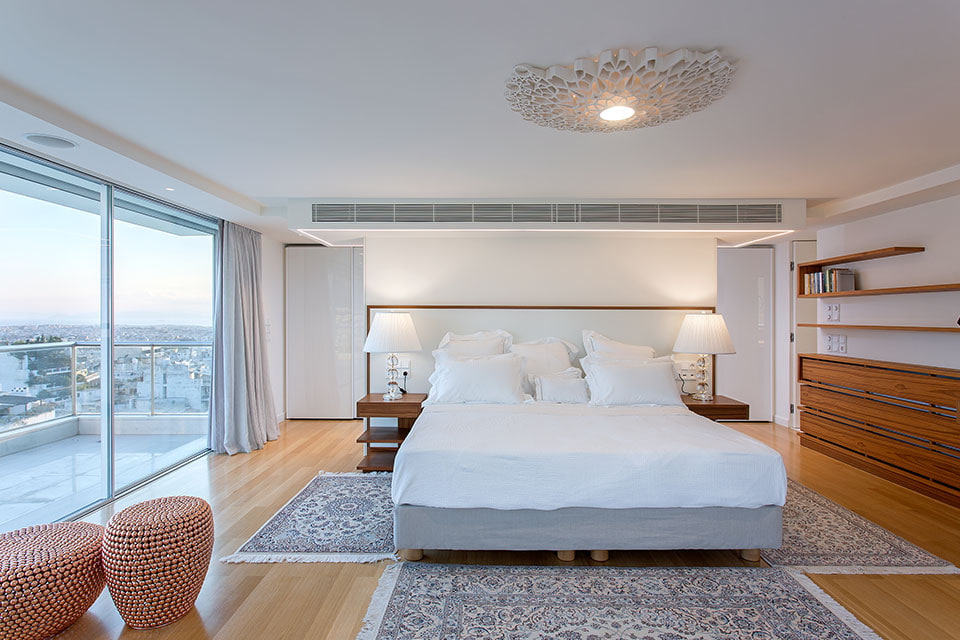
Notredame
Wall lamps
Like bright footprints that do not go unnoticed, because behind each of them there is a detail that makes the difference, wall lamps are an ideal type of designer indoor lighting that provide task lighting and illuminate areas used for activities and work.
For example, two wall lamps placed above bedside tables represent a valid alternative to the classic lampshades, while on either side of the bathroom mirror, they provide all the necessary functional light.
Wall lamps are also an excellent source of accent lighting and can be installed to call attention to pieces of furniture and works of art performing a dual role: to illuminate and be undisputed design elements.
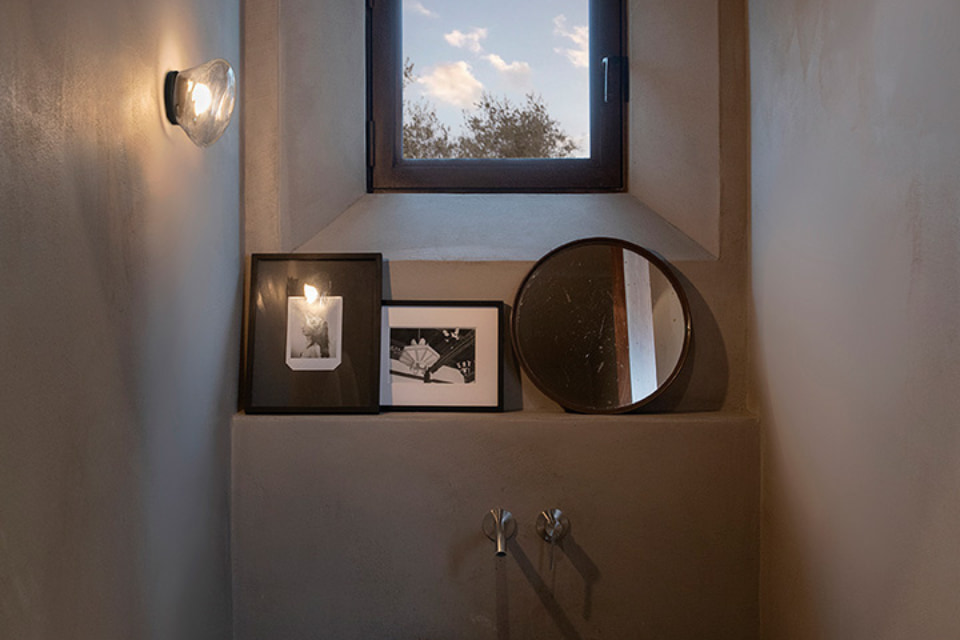
Agua
Floor lamps
Floor lamps are real lighting accessories, capable of immediately connoting the environment and dressing it with a strong personality.
This type of indoor lighting allows you to add levels of illumination and play with light.
Perfect, positioned next to a sofa, to give an intimate and soft atmosphere, but also to give life to a forgotten room or enhance a corner of the bedroom or a hotel reception.

Ululì - Ululà
Table lamps
Table lamps are another type of indoor lamp that can create surprising lighting effects.
If placed on a desk or bedside table, they represent an excellent source of task lighting; while a table lamp pointing towards a design object becomes the perfect idea for accent lighting.
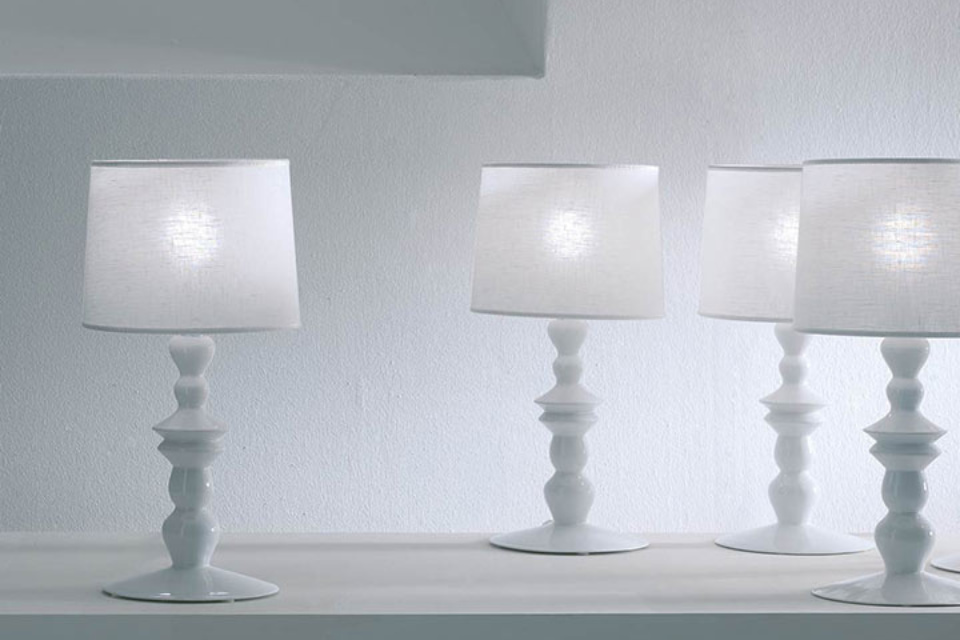
Alibababy
How to choose the right lighting
As we have seen, architects and interior designers, in developing a lighting design project, must take into account different types of indoor lighting.
These are not exclusive categories and one option does not exclude another.
On the contrary, choosing the right lighting means combining, matching, and using each type wisely.
That is how artificial light becomes the completion of the natural one; the three levels of lighting, carefully considered, become a whole capable of creating evocative and emotionally engaging atmospheres.
Likewise you'll have to find the perfect balance between decorative and technical lighting; while a wise use of direct and indirect lighting will allow you to set up the desired atmosphere and obtain pleasant and uniform lighting.
Finally, when choosing between the different types of indoor lamps, it is necessary to choose the solutions that by design, size, and style are better suited to the concept that you want to develop.
Also, in this case, the mix & match, used intelligently, becomes the turning point for a project that focuses on aesthetics and scenographic effect without sacrificing functionality.
Karman's Made in Italy lamps combine quality and technique for an emotional lighting destined to leave its mark.




